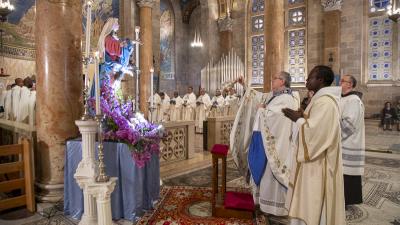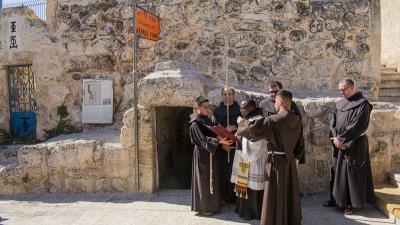
For hundreds of years, the Lenten liturgies at the Holy Sepulcher have been repeated identically. The witness of Mariano da Siena, a pilgrim in 1431, shows the same schedule of prayers that took place on the third Sunday of Lent. The vespers on Saturday and on the eve, which only during the time before Easter, are accessible to all of the faithful, have kicked off the third Sunday of this important season. As expected, on the morning of Sunday, March 19 , the kawas escorted the Franciscan friars of the Custody of the Holy Land to the headquarters of the Latin Patriarchate of Jerusalem. The Apostolic Administrator, Mons. Pierbattista Pizzaballa, also made his entrance to the Holy Sepulcher, accompanied by the friars and welcomed by the guardian of the fraternity, Fr. Zacheusz Drazek.
Beside the Shrine of the Empty Tomb, whose opening after the restoration work approaching (http://it.custodia.org/default.asp?id=4&id_n=32816), on the altar of St. Mary Magdalene there took place the solemn Eucharistic celebration, preceded by the prayer of praise. The songs in Latin fused with the organ music and with Coptic and and Greek Orthodox songs. The uniqueness of Easter this year is the fact that the festivities fall on coinciding dates for the various Christian churches and so prayers in the Church of the Resurrection are taking place at the same time. The homily was given in Arabic by Fr. Sebastiano Eclimes, the guardian of Dominus Flevit, from the pulpit of the Chapel of St. Mary Magdalene. The friar first retraced the journey of Lent that has been undertaken thus far: “On the first Sunday, we saw that God invited us to know the mystery of Christ as a man, tempted by the devil, and how in the end he came out victorious. So, also for the second Sunday: Matthew the Evangelist opens a more direct path for us to enter into the mystery of Christ, who was transfigured on Tabor, the mystery that is the light of God, which appears in Christ. [...] On this Sunday, Christ appears as the living water that can quench thirst forever. This is the story of the Samaritan woman.”
Br. Sebastiano then focused on those who are truly thirsty: the suffering, the people who suffer due to wars, who are eager for justice and even those who do evil and teach hatred to others. They are men who have denied God and who have turned away from him in their lives. “The personal knowledge of Christ erases any thirst, hatred, violence, envy,” said the guardian of Dominus Flevit.
For all of the pilgrims and those who are in the Holy Land, knowledge of Christ can also be gained in the Lenten pilgrimages which every year retrace the places linked to Jesus' passion. In the coming Wednesdays, some solemn masses will take place in Gethsemane (March 22), at the Flagellation (March 29) and at the Lithostrotos (April 5), in addition to the pilgrimage to Bethany on March 29. For the next two weeks before Palm Sunday, the Lenten liturgies, which are open to pilgrims, with procession and a vigil mass on Saturday evening and a mass on Sunday morning, will continue at the Holy Sepulcher.
Beatrice Guarrera
Related articles
Praying at night on the second Sunday of Lent
Jesus' Tomb: the opening will not mark the end of the work
Lent has begun in the Holy Sepulcher




